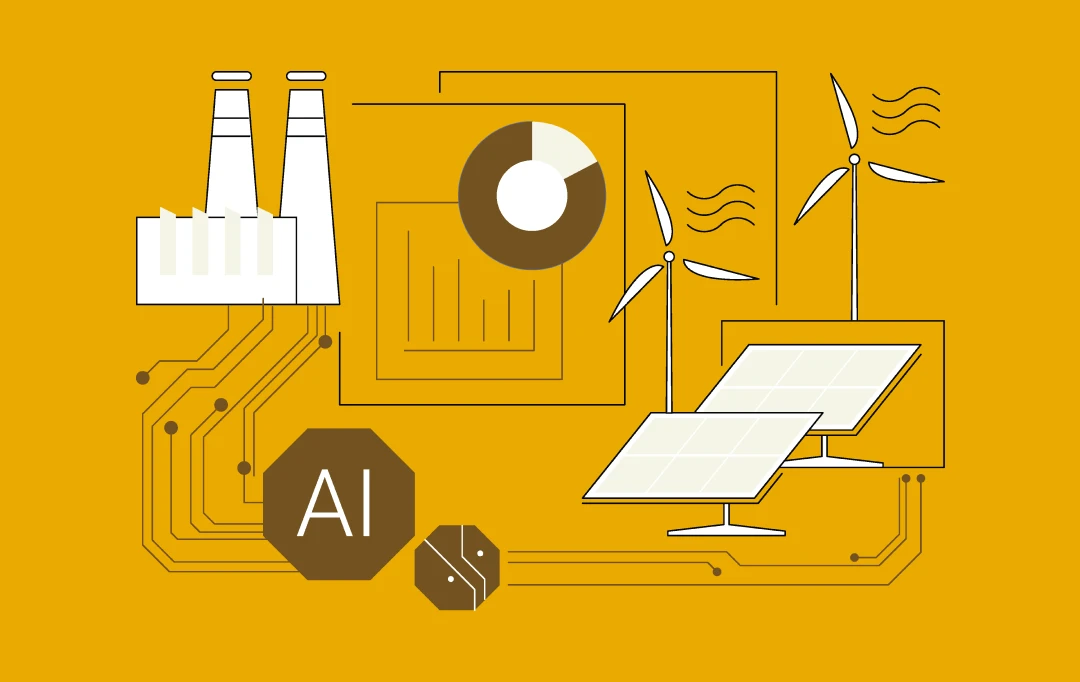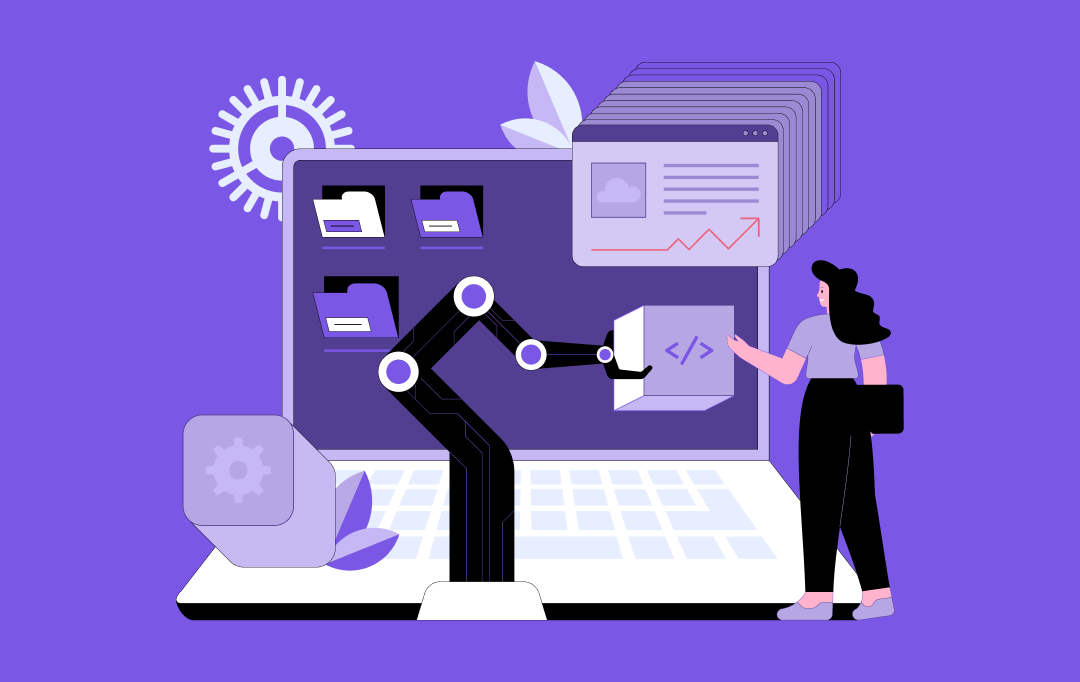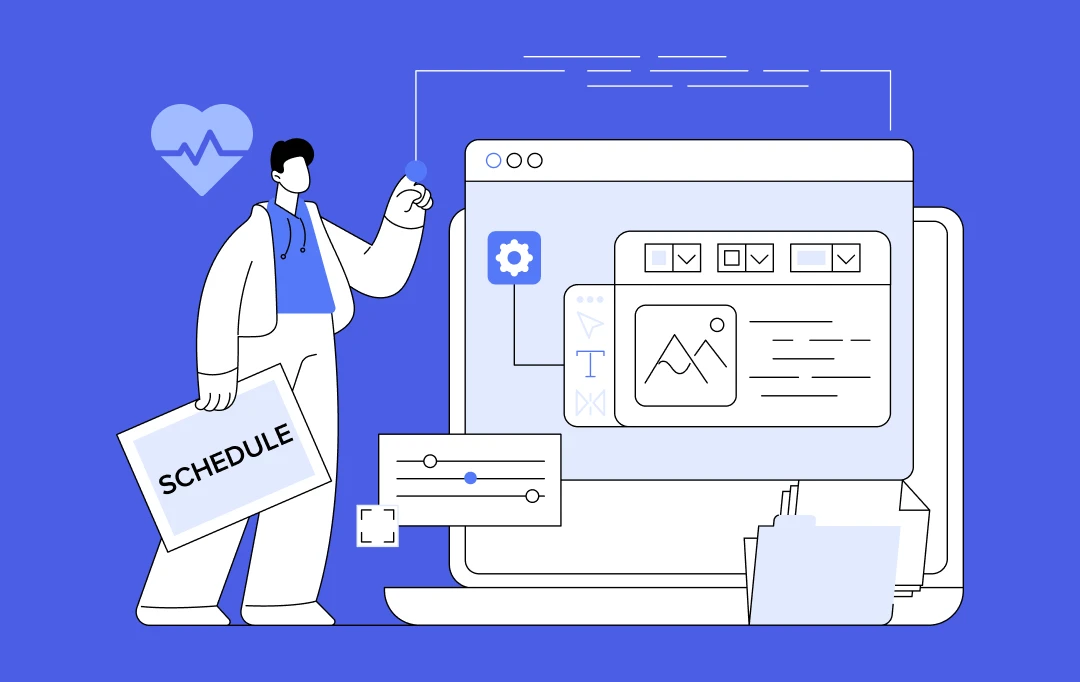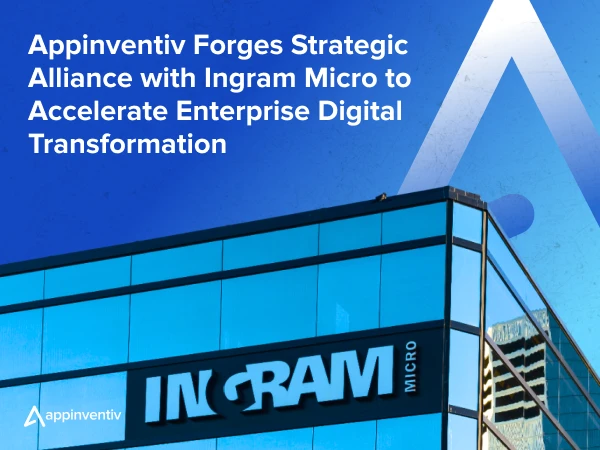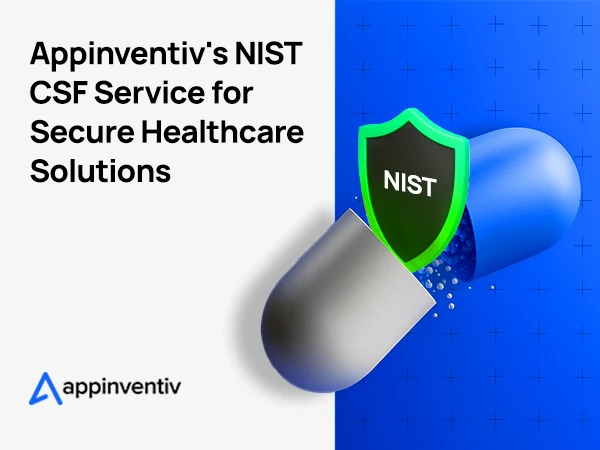- Unpacking the Layers & Architecture of Embedded Software Systems
- Firmware: The Foundation Layer
- Device Drivers: The Communication Bridge
- Real-Time Operating Systems: The Task Manager
- Middleware: The Integration Layer
- Embedded Linux: The Flexible Framework
- Application Software: The User Interface
- Classifications That Define Modern Embedded Systems
- The Journey of Creation: 8 Key Steps to Build Embedded Software Effectively
- Defining the Project Scope
- Choosing the Correct Hardware Platform
- Software Architecture Design
- Creating the Firmware
- Implementing Communication Interfaces
- Ensure Dependability and Security
- Performing Tests and Debugging
- Improving Memory Usage and Performance
- Embedded Software Development Challenges and Solutions
- Stability
- Safety
- Cyber Security
- Scalability
- The Developers’ Toolkit: Essential Embedded Software Development Tools
- Cross-Compilers
- Integrated Development Environments (IDEs)
- Debuggers
- Simulators and Emulators
- System Configuration and Code Generation Tools
- Real-World Applications: Embedded Software Examples All Around Us
- Consumer Electronics
- Industrial Automation
- Medical Devices
- Aerospace Software
- Smart Infrastructure and IoT
- Automotive Systems
- Unlocking Efficiency: The Importance of Embedded Software Systems for Business Efficiency
- Real-Time Monitoring and Control
- Data Analytics and Insights
- Process Automation
- Integration with Existing Systems
- Remote Management and Connectivity
- Predictive Maintenance
- The Cost of Crafting Intelligence: Embedded Software Development Investment
- Project Scope and Complexity
- Integration and Compatibility
- Security and Regulatory Compliance
- Software and Hardware Requirements
- Long-Term Support and Maintenance
- Peering into the Future: Trends in Embedded Software Development
- Count on Appinventiv for Your Embedded System Software Development Project
- FAQs
The embedded software landscape has witnessed significant evolution in recent years. The revolution is majorly driven by the integration of artificial intelligence (AI), Internet of Things (IoT), robust security measures, 5G connectivity, and other emerging technological trends. These tech integrations are expected to drive unprecedented innovation and digital transformation across various industries in 2025 and beyond.
Embedded software development is not just another tech trend. It is the invisible force that fuels nearly every smart device, making our lives easier. From the coffee maker that starts brewing before your alarm rings to the autonomous vehicles navigating our streets, embedded software is the digital brain behind modern innovation.
This is the reason that the global market for embedded software is booming, projected to reach $30.23 billion by 2030, with an estimated value of $17.90 billion in 2024 (Source: Grand View Research). Several powerful trends fuel this impressive growth:
- The proliferation of IoT devices: Everything from smart homes to connected factories relies on embedded software.
- Advancements in hardware technology: Smaller, more powerful, and energy-efficient hardware open up new possibilities.
- Industry 5.0 revolution: Collaborative robots (“cobots”) and AI-powered systems that augment human capabilities, leading to more personalized products.
- Adoption of edge computing: Processing data closer to the source (the “edge”) reduces latency and enhances efficiency, allowing for quicker decisions and less reliance on constant cloud connectivity.
- AI and Machine Learning Integration: The ability to embed AI models directly onto devices is transforming how they process data, make decisions, and interact with the world.
- 5G Technology Adoption: The rollout of 5G is accelerating the demand for embedded software.
For entrepreneurs or business leaders, venturing into embedded software development is no longer optional. It is a dire necessity for staying competitive in today’s hyper-connected world. By developing embedded software solutions, businesses can create intelligent devices. These smart devices help enhance customer experiences and streamline workflows, which ultimately leads to a greater return on investment.
In this comprehensive guide, we will peel back the layers of custom-embedded software, walking you through the essential steps, tools, and best practices. You’ll also discover real-world examples and gain an understanding of the business benefits of robust embedded software solutions.
Our embedded software consultants are here to help you map out the right architecture, tools, and timeline for your vision, helping you bring your project to life.
Unpacking the Layers & Architecture of Embedded Software Systems
Embedded systems operate through software-hardware interaction. The software instructs the hardware components on how to process data, perform calculations, and communicate with other devices. This is achieved through specialized printed-circuit boards, which program the hardware to carry out specific tasks.
As a result, embedded systems can perform their functions in real-time, providing users with the required output. Embedded software systems are designed to work within the device hardware, enabling autonomous task performance.
Let’s have a closer look at the key layers that make up an embedded software architecture:
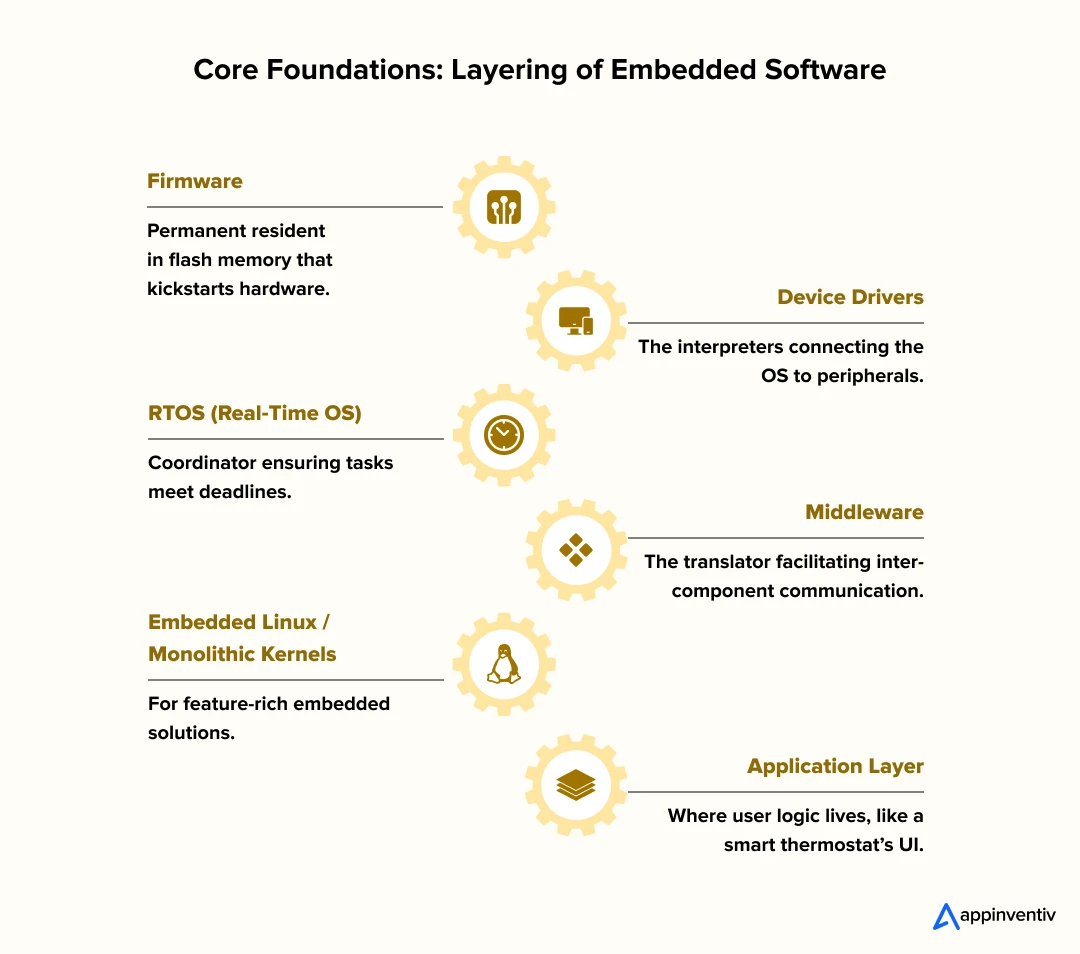
Firmware: The Foundation Layer
This is the foundational layer, permanently stored in the device’s memory. This layer manages the fundamental functions of a smart device. This kind of embedded software is permanently recorded in the hardware. It is frequently in charge of controlling booting processes, low-level operations, and maintaining hardware interfaces.
Device Drivers: The Communication Bridge
Device drivers are crucial components of embedded software that facilitate connecting the operating system (OS) and hardware devices. They play a key role in connecting the operating systems with devices such as printers and sensors. Device drivers ensure optimal functionality and seamless communication between the OS and these devices.
Real-Time Operating Systems: The Task Manager
Real-Time Operating Systems, or RTOS, are designed for real-time embedded systems. Its main function is to schedule and manage tasks, making it easier for applications that provide quick responses. By enabling the timely execution of vital operations, RTOS ensures the smooth functioning of such applications.
Middleware: The Integration Layer
Middleware is yet another component in embedded systems that facilitates communication between different software components. By offering shared features and services, middleware simplifies software development by eliminating complex capabilities. This elimination helps developers focus on their software components’ core functionalities while relying on middleware to handle the complexities of inter-component communication.
Embedded Linux: The Flexible Framework
Embedded Linux is the tailored version of the Linux OS designed for embedded systems. It offers a reliable and flexible framework for developing embedded software applications and is widely utilized in various devices. Its adaptable and reliable features make it a popular choice in the industry.
Application Software: The User Interface
This is the topmost layer, the part that users or other systems directly interact with. It’s where the specific logic and features that define the device’s purpose reside – for instance, the smart thermostat’s algorithm for adjusting temperature based on schedules and sensor data.
| How These Layers Interact When an embedded device powers on, the firmware first initializes the hardware. Then, if present, it loads the RTOS or Embedded Linux. Middleware then steps in to enable communication between various internal components. Finally, the application software leverages all these underlying layers to deliver the device’s intended functions, providing the user with a seamless experience. |
Classifications That Define Modern Embedded Systems
Embedded systems come in various forms, each designed for specific performance requirements and interactions:
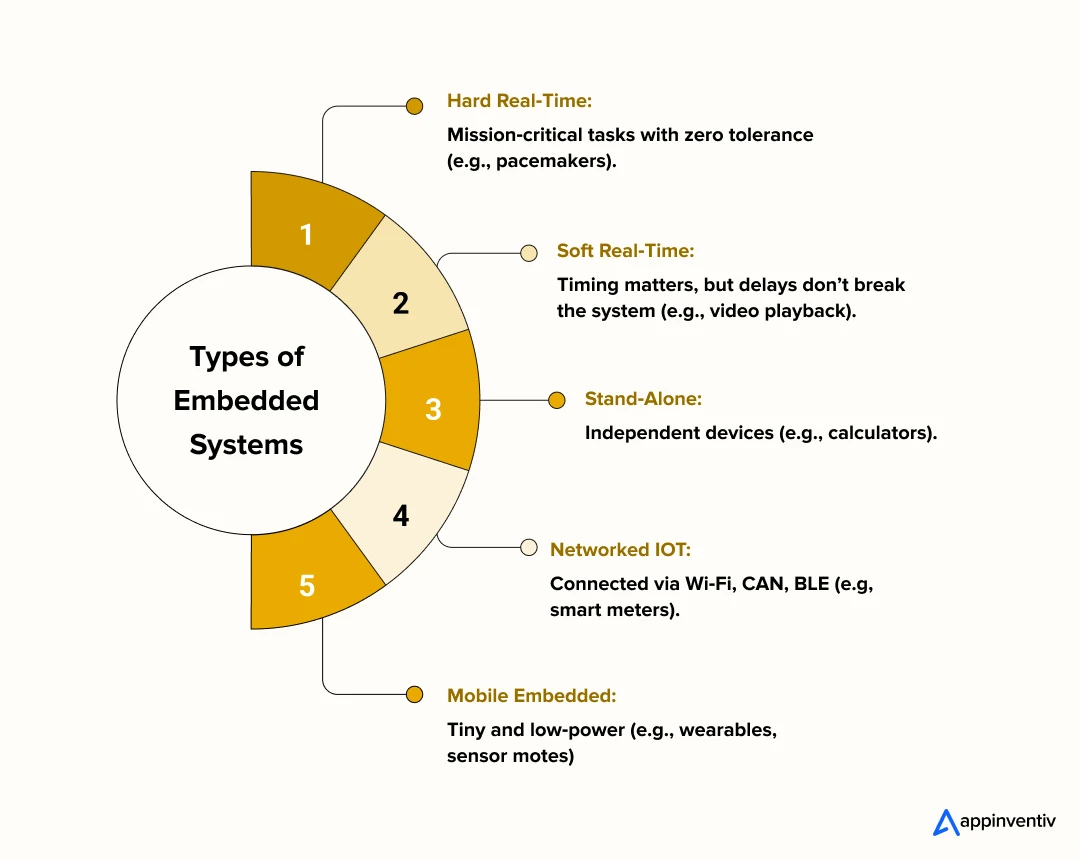
Real-Time Embedded Systems: In real-time embedded software development, timing is paramount.
- Hard Real-Time Systems: Mission-critical applications with strict timing constraints where failure to meet deadlines can result in catastrophic consequences (pacemakers, airbag systems).
- Soft Real-Time Systems: Applications where timing is important but not critical, allowing for occasional deadline misses without system failure (streaming media, gaming consoles).
Stand-Alone Embedded Systems
These are the lone wolves, like calculators or digital cameras, doing their thing without needing to connect to anything else.
Networked Embedded Systems
These are the social butterflies, linked up via Wi-Fi or Bluetooth to power smart meters, security systems, or even entire smart cities. They’re all about staying connected.
Mobile Embedded Systems
Built for portability, these systems power your smartwatch, phone, or portable medical gadgets. They are tiny, energy-efficient, and ready to go wherever you do.
These layers and types of embedded software perform a wide range of functions that embedded systems can support. Each type of embedded system, with its specific layers and functionalities, contributes to the vast ecosystem of smart devices that define our modern world. Let’s now check out the steps for developing robust and scalable embedded software.
The Journey of Creation: 8 Key Steps to Build Embedded Software Effectively
Embedded system development is an intricate process that requires meticulous attention to detail and a deeper understanding of hardware and software integration. Below is the step-by-step process of developing custom embedded software.

Defining the Project Scope
Every successful embedded software development project begins with a distinct vision and well-articulated goals. Start by analyzing the functionalities of your embedded system, determining the application for which it is intended, and comprehending the requirements and limitations it must adhere to.
Choosing the Correct Hardware Platform
This is a critical decision. Collaborate with your chosen embedded software engineering services provider (like Appinventiv!) to select the ideal hardware. Consider factors like processing power, memory capacity, communication interfaces, and power consumption. Modern platforms now prioritize AI capabilities and edge computing features to support intelligent device functionality. The right hardware sets the stage for efficient software.
Software Architecture Design
The embedded system’s software architecture serves as the backbone of your project. This ensures that all components work together seamlessly. Whether it’s a layered architecture, an event-driven architecture, or a state machine architecture, the experienced embedded systems development services provider carefully selects the best architecture that best suits your needs.
Creating the Firmware
The core of developing embedded software is writing the firmware. The development team utilizes the best programming languages, such as C, C++, or Python, that are compatible with the hardware. Modern embedded software increasingly incorporates AI/ML libraries and edge computing capabilities, requiring developers to strike a balance between performance and intelligent features.
Implementing Communication Interfaces
After creating the firmware, the embedded software developers integrate the right communication interface for data interchange and remote control. This includes wired options, such as SPI, UART, or I2C, as well as wireless options, including Wi-Fi, Bluetooth, or LoRa. 5G integration is becoming standard for high-bandwidth applications requiring ultra-low latency. The interface choice depends on the project’s requirements and the desired communication method.
Ensure Dependability and Security
With cyberattacks occurring every 39 seconds globally (Source: Astra), embedded systems become the prime targets for security breaches. That’s why security isn’t optional; it’s critical. To protect against such threats, the development team implements robust security features, including encryption, authentication, and secure boot protocols.
Performing Tests and Debugging
To ensure that the software performs seamlessly under numerous circumstances, the QA team conducts an extensive testing process. This process involves finding and repairing bugs early, combining unit, integration, and system testing. The QA experts rely on AI-powered automated testing tools and security penetration testing to ensure reliability and safety.
Improving Memory Usage and Performance
Your embedded system development team ensures that unnecessary overhead expenses are minimized. The experts consistently upgrade and monitor the performance of your embedded software system to ensure its smooth functioning and improved memory usage.
Embedded Software Development Challenges and Solutions
Embedded software development comes with its own set of challenges, from ensuring system stability to maintaining high levels of safety and security. Addressing these challenges is essential to ensure optimal performance, seamless device integration, and the long-term reliability of embedded systems.
Stability
- Challenge: Embedded systems frequently operate in real-time environments where even minor instability can lead to system crashes or unpredictable behavior, which is unacceptable for critical applications.
- Solution: To guarantee system stability, developers employ rigorous testing, including stress testing, real-time performance analysis, and extensive hardware-in-the-loop (HIL) simulations. Thorough validation across various operational scenarios helps uncover and rectify potential weaknesses before deployment.
Safety
- Challenge: Safety is paramount, especially in industries like aerospace, automotive, and medical devices, where a software malfunction could have life-threatening consequences. Compliance with strict industry standards is often mandatory.
- Solution: Developers must strictly adhere to industry safety standards (e.g., ISO 26262 for automotive, IEC 62304 for medical devices) and regulations. Implementing redundancy (backup systems), fail-safe mechanisms, and comprehensive hazard analysis and risk assessments (HARA) is crucial to ensure the software operates reliably and safely in all conceivable scenarios.
Cyber Security
- Challenge: With the growing number of connected IoT devices, embedded systems have become prime targets for cyberattacks. Security breaches can compromise sensitive data, disrupt critical operations, and even lead to physical damage.
- Solution: To fortify defenses, implement secure coding practices from the outset. Robust encryption for data at rest and in transit, regular security audits, strong authentication protocols, and mechanisms for secure boot and over-the-air (OTA) updates are indispensable. They help protect against unauthorized access and malicious attacks. You can implement AI-based cybersecurity and threat detection mechanisms to identify anomalous behavior in real-time.
Scalability
- Challenge: Embedded systems typically operate with highly limited resources (memory, processing power, energy). Expanding functionality, integrating more sensors, or increasing the number of deployed devices makes it challenging to scale the software without compromising performance.
- Solution: Achieving scalability requires a proactive approach from the design phase. This includes adopting a modular software architecture, optimizing code for resource efficiency, and designing systems that can leverage edge or cloud processing for heavier workloads. Using standardized interfaces and planning for over-the-air (OTA) updates also ensures that future expansions can be managed efficiently without physical access to every device.
Here is a brief overview of some common challenges in embedded systems development, along with best practices to overcome those barriers.
| Challenge | Embedded System Development Best Practices |
|---|---|
| Stability | Use watchdog, stress & real‑time testing |
| Safety | Align with ISO 26262, add redundancy, and run HAZOP |
| Security | Secure‑boot, encryption, and regular audits |
| Scalability | Choose modular architecture and OTA update support |
Now that you know the embedded software development process, challenges, and best practices, let’s move on to discuss the top embedded software tools that can help you overcome these challenges. These tools are designed to streamline your workflow and enhance efficiency. You can optimize your embedded system development and achieve superior results by leveraging these highly efficient tools. Let’s check them out:
The Developers’ Toolkit: Essential Embedded Software Development Tools
Embedded software development tools are essential for producing reliable and effective software for embedded devices. These tools support developers in managing various aspects of the embedded system development process, including authoring, debugging, testing, and optimizing code. Here are a few typical tools for creating embedded software:
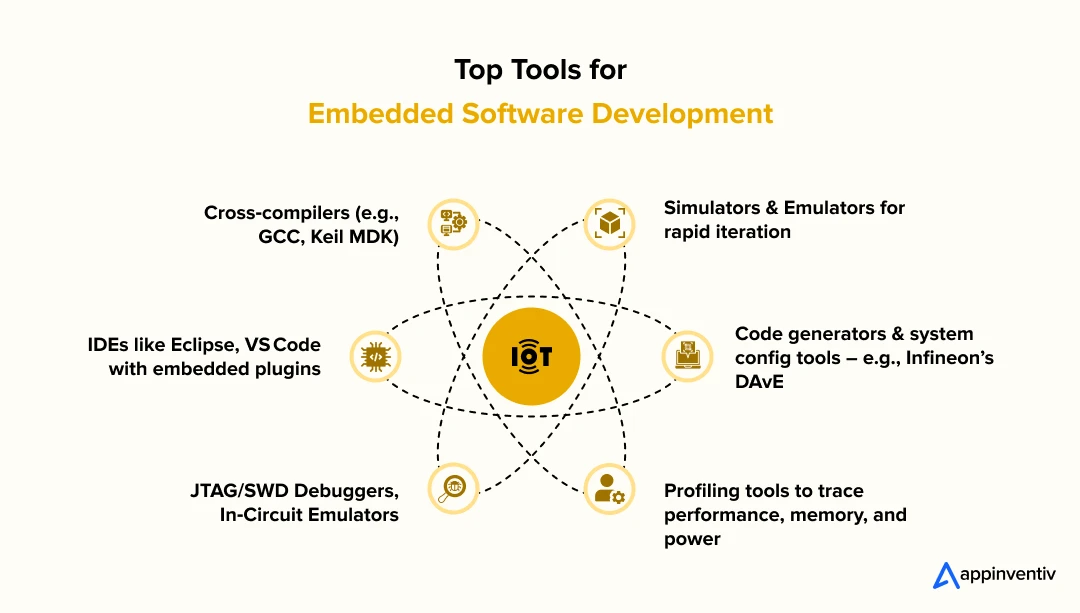
Cross-Compilers
Cross-compilers allow code to be built on one platform, like a PC, and then compiled for the target embedded system. This saves time and effort by eliminating the need to write code specifically for each individual hardware architecture. With cross-compilers, developers can efficiently generate code that optimizes resource utilization and performance for the target system.
Integrated Development Environments (IDEs)
Code editors, debuggers, compilers, and other tools are all included in Integrated Development Environments (IDEs), which offer a complete development environment on a single platform. Eclipse, Code Composer Studio, and Visual Studio Code (with modules for embedded development) are popular embedded IDEs.
Debuggers
Debuggers are an essential tool for developers. This provides them with the necessary features to find and fix bugs in their code efficiently. These debuggers offer a range of capabilities that greatly aid in real-time debugging on the target hardware. With features like breakpoint management, developers can easily pause the execution of their code at specific points to identify issues.
Simulators and Emulators
Simulators and emulators let developers test and debug their code without deploying it to an embedded system on a host computer. They offer a virtual replica of the intended hardware, making testing quicker and more adaptable.
System Configuration and Code Generation Tools
Some embedded systems use tools that make configuring and generating code from high-level specifications easier. These technologies aid in minimizing manual coding errors and labor.
With the right embedded software development tools, developers can significantly enhance their productivity, reduce time-to-market, and deliver superior software solutions for embedded devices.
Real-World Applications: Embedded Software Examples All Around Us
You might not realize it, but embedded software examples are woven into the fabric of our daily lives. Most electronic devices and appliances we interact with house this invisible intelligence. Here are some of the best examples:
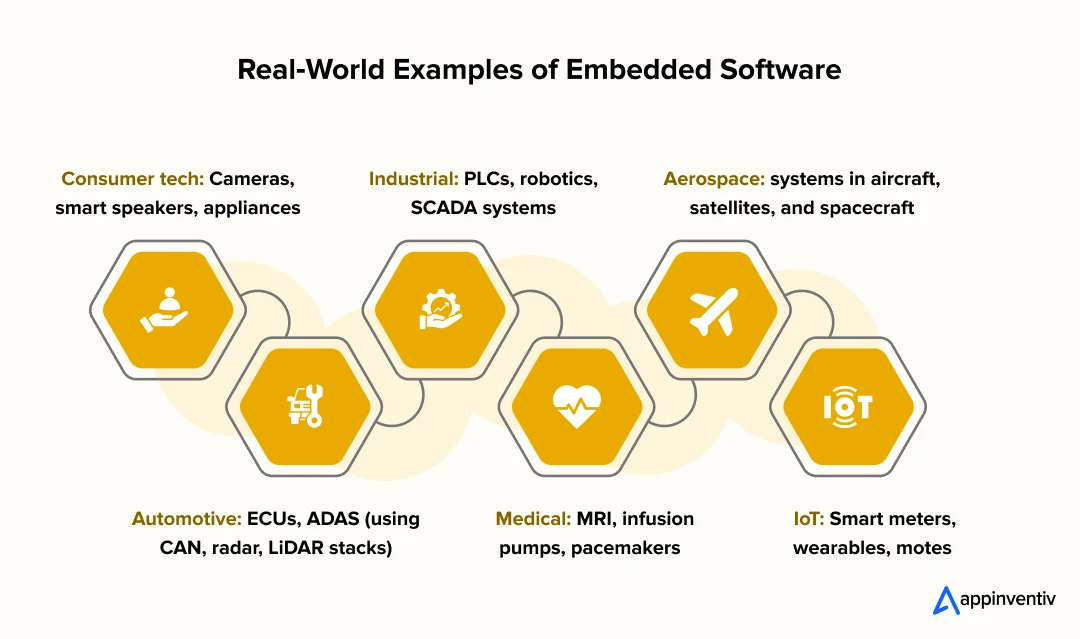
Consumer Electronics
From smartphones and smart TVs to digital cameras and household appliances like washing machines and refrigerators, consumer electronics embedded software development is the brain behind their advanced capabilities. This software ensures seamless functionality across various smart devices, enhancing the user experience.
Industrial Automation
In factories and industrial settings, industrial embedded software development is the backbone of efficiency. It’s used in programmable logic controllers (PLCs), industrial robots, and manufacturing equipment to control processes, monitor operations, and ensure precision.
Medical Devices
For accurate control and monitoring in healthcare, devices like pacemakers, MRI scanners, and infusion pumps rely heavily on embedded software. However, medical device embedded software development demands the highest levels of reliability and precision.
Aerospace Software
In the skies and beyond, aerospace embedded software development powers critical systems in aircraft, satellites, and spacecraft. This includes avionics systems for flight control, navigation, communication, and engine management. The software in aerospace applications must meet incredibly stringent safety, reliability, and real-time performance requirements due to the high-stakes environment.
Smart Infrastructure and IoT
Smart cities, energy grids, and environmental monitoring systems rely on embedded software for data collection, analysis, and automated responses. Smart thermostats, wearables, home security systems, and countless other connected gadgets use embedded software to enable communication, process data locally (edge computing), and interact with cloud services.
Automotive Systems
Modern cars are essentially computers on wheels. Embedded software manages critical functions, such as engine control, anti-lock brake systems (ABS), sophisticated infotainment systems, and advanced driver assistance features (ADAS). This contributes to safety and convenience, including features that support autonomous driving. The precision and reliability of automotive embedded software development are paramount for vehicle performance and passenger safety.
Unlocking Efficiency: The Importance of Embedded Software Systems for Business Efficiency
Embedded software solutions are not just about making devices smart. They are powerful drivers of business efficiency. By refining procedures, automating operations, and optimizing resources, embedded software systems can enhance business efficiency. Here are some ways that embedded software boosts operational effectiveness in businesses:
![]()
Real-Time Monitoring and Control
Businesses can make swift decisions because of the embedded software’s ability to monitor and control crucial operations in real-time. This real-time capability enables businesses to make informed decisions, reduce downtime, and ensure seamless performance.
Data Analytics and Insights
Embedded software plays a crucial role in gathering and interpreting data from sensors and other devices. This enables businesses to gain valuable data-driven insights. These insights provide a solid foundation for enhancing business activities and achieving better results.
Process Automation
Embedded software can automate time-consuming and repetitive operations. Thai reduces the need for human intervention and the possibility of errors. Through intelligent automation, workflows can be carried out more quickly and accurately, saving both time and resources.
Integration with Existing Systems
Embedded software seamlessly integrates with existing business systems, including customer relationship management (CRM) and enterprise resource planning (ERP) systems. This integration enhances overall business coordination and facilitates smooth data flow. Embedded software ensures efficient communication and synchronization between different organizational departments and functions by interfacing with these systems.
Remote Management and Connectivity
Embedded software systems enable remote management and connectivity. This allows organizations to monitor and manage devices from any location. This remote management access makes upgrades, troubleshooting, and maintenance more effective.
Predictive Maintenance
Businesses can anticipate device issues and schedule maintenance ahead of time by utilizing embedded software that runs predictive maintenance algorithms. This proactive approach helps minimize unplanned downtime and maximize the utilization of assets. By analyzing data and identifying potential problems before they occur, businesses can take necessary actions to prevent equipment failures and optimize operational efficiency.
Also Read: Predictive Analytics Software Development Guide 2025
Now that you know all the nitty-gritty of embedded software development and its importance for enterprises, let’s answer the pressing concern that businesses often ask: “How much does embedded software development cost?”.
The Cost of Crafting Intelligence: Embedded Software Development Investment
There is no one-size-fits-all approach to answering what is the cost of embedded software development. The project requirements vary, and so do the costs. Thus, considering the financial aspect of developing and implementing embedded software into your existing systems is important. The cost estimation process involves a thorough analysis of various factors, which include:
Project Scope and Complexity
Clearly outline the project’s scope, taking into account the hardware platform, desired functionality, and performance goals. The degree of customization required and the complexity of the embedded system will have a significant impact on the development cost.
Integration and Compatibility
When evaluating integration and compatibility, it is important to consider the process required to integrate the embedded software with current systems or external components. This process can be complex and costly. For instance, ensuring interoperability with other systems may require additional resources and effort.
Security and Regulatory Compliance
If the custom embedded software needs to adhere to specific industry norms or legal regulations (e.g., medical devices, automotive systems), you must consider the additional work and expenses for compliance. Industry-specific standards and certifications add to development costs but are essential for market access and legal compliance.
Software and Hardware Requirements
Identify the software and hardware elements required for embedded system software development. The cost of various hardware platforms and software licensing varies. This impacts the project budget.
Long-Term Support and Maintenance
Consider the ongoing costs for software updates, bug fixes, security patches, and continued technical support. A well-planned maintenance strategy is crucial for the longevity and reliability of the embedded system.
| Ongoing updates and maintenance can account for 15-20% of the initial development cost annually. |
|---|
Considering these factors, the embedded software development pricing typically ranges anywhere between $40,000 and $400,000, and sometimes even higher for highly complex and enterprise-grade projects.
Peering into the Future: Trends in Embedded Software Development
The embedded software landscape is not standing still; it’s evolving fast, riding the wave of enterprise AI, edge computing, and hyperconnectivity. As businesses race to build smarter, faster, and more secure systems, the future of embedded software development is being shaped by some powerful trends. Let’s take a closer look at what’s ahead in the coming years.
- AI and ML Integration: Devices are becoming exponentially smarter. The integration of AI and ML algorithms into embedded software enables predictive analytics, autonomous decision-making, and highly personalized user experiences.
- Edge Computing: The paradigm of edge computing in enterprises is gaining immense traction. Processing data closer to its source, right on the embedded device, leads to faster response times, reduced latency, and more efficient operations by minimizing reliance on cloud connectivity.
- Over-the-Air (OTA) Updates: The ability to perform remote software updates (OTA) has become standard practice. This is vital for improving security, adding new functionalities, fixing bugs, and ensuring devices remain up-to-date throughout their lifecycle without physical intervention.
- Advanced Security Measures: As cyber threats become more sophisticated, so too do the security measures within embedded software. Innovations in encryption, multi-factor authentication, secure boot protocols, and hardware-level security are continuously being developed to safeguard devices and data.
- Greater Interconnectivity: The ever-expanding IoT is driving the need for seamless communication between a multitude of devices. This leads to the development of new communication standards, protocols, and architectures that facilitate robust and efficient device-to-device and device-to-cloud interactions.
Count on Appinventiv for Your Embedded System Software Development Project
You have seen how embedded software development isn’t just about lines of code; it’s about crafting the intelligence that makes devices smart, reliable, and truly transformative. Whether you are dreaming of the next breakthrough IoT device, optimizing industrial processes with real-time control, or building the critical systems of tomorrow’s autonomous machines, the path forward requires deep expertise and a steady hand.
That is precisely where we at Appinventiv step in. Our skilled team of 1600+ software experts is dedicated to providing customized embedded software solutions that cater to your specific requirements. They don’t just write code; they architect custom embedded software solutions that fit your specific requirements like a glove.
From conceptualizing to deployment, we offer end-to-end embedded software development services that ensure a seamless development process. Our commitment extends beyond development, as we provide ongoing support and maintenance to ensure that your embedded software remains optimized and up-to-date. We deliver high-performance and future-ready embedded software by leveraging advanced technologies and implementing rigorous quality assurance measures.
With Appinventiv, you can unlock the full potential of your embedded software development project and drive innovation in your industry. Get in touch with us now — your intelligent future awaits!
FAQs
Q. What is embedded software development?
A. Embedded software development is about making the systems that runs inside specific devices. Like the code in a smartwatch or a car’s system that tells it what to do. It’s built for one job and lives in the device’s hardware.
This type of software is essential for powering various devices, including consumer electronics and industrial systems, and enables them to perform specific tasks with intelligence and functionality.
Q. How is embedded software different from traditional software?
A. Here are some of the most common differences between embedded and traditional software
Embedded stuff is for one device, like a thermostat. Regular software is for phones or computers and does lots of things.
- Embedded systems have to work with little power or memory. Regular software has more room to play.
- Embedded needs to be super fast sometimes, like for car brakes. Regular software doesn’t care as much about speed.
- Embedded is stuck to the device’s hardware. Regular software runs on standard systems like Windows.
Q. What is an example of embedded software development?
A. Embedded software development plays a crucial role in the functionality of various consumer electronics and home automation devices. An example of this is the firmware used in a smart thermostat. The embedded software within the thermostat controls temperature settings, monitors sensors, and facilitates communication with a user interface or mobile app.
By leveraging this software, the thermostat gathers user preferences, optimizes energy usage, and creates a comfortable environment. This exemplifies the versatility and importance of embedded software in enhancing the user experience and promoting energy efficiency in everyday life.
Q. What is the cost of developing embedded software?
A. The cost of developing embedded software ranges between $40,000 and $400,000. However, this is just a rough estimate; the actual cost of development involves a detailed analysis of various factors, including the software’s complexity, the required hardware, development time, and the expertise of the development team. Additionally, licensing fees, maintenance costs, and potential future upgrades also influence the total cost of embedded software development.
An accurate cost estimation can be determined by carefully evaluating these aspects, ensuring that the project remains within budget and meets the desired objectives.
Connect with an embedded software development company for a detailed discussion on cost estimation.
Q. How long does it take to build embedded software?
A. Simple projects take 3–6 months, like basic device code. Medium ones, like smart home gadgets, need 6–12 months. Big ones, like car systems, can take 1–3 years. It’s all about planning, coding, testing, and matching the hardware.
Q. How does embedded software impact IoT adoption and digital transformation in enterprises?
A. Embedded software is the backbone of IoT adoption and a catalyst for digital transformation in enterprises. It lets devices collect, process, and send data. This allows for live tracking, predicting problems, and automating tasks. By processing data right on the device, embedded software makes things faster and uses less internet. This helps with quick decisions. Device-level smarts are key for connected systems. They make things more efficient, offer new insights from data, and create new business ideas through digital change.
Q. What kind of ongoing maintenance and support is required for embedded software solutions?
A. Ongoing maintenance and support are critical for the longevity and optimal performance of embedded software solutions. This typically includes:
- Updates to fix bugs or add new stuff.
- Security patches to stop hackers, especially for internet-connected devices.
- Making sure it works with old or new hardware.
- Checking for problems before they break things.
- Following rules, like for medical or car devices.
- Helping users when something goes wrong.
Proactive maintenance helps extend the device’s lifespan, minimizes downtime, and ensures continuous value delivery.
Q. What are the benefits of embedded software development outsourcing for an enterprise?
A. Getting outsourcing help for embedded software development can really benefit businesses:
- Expert skills: You get access to a global pool of experts in embedded systems, which might be costly or difficult to find in-house.
- Reduced development costs: Lower overheads by avoiding in-house recruitment, training, infrastructure, and equipment expenses.
- Faster time-to-market: Leverage the outsourcing partner’s streamlined processes, established methodologies, and dedicated teams to accelerate project timelines.
- Increased flexibility and scalability: Easily scale resources up or down based on project demands without the complexities of managing an internal team.
- Focus on core business: Free up internal resources to concentrate on strategic initiatives, innovation, and core competencies.
- Better quality: You benefit from the partner’s experience, thorough testing, and high standards.


- In just 2 mins you will get a response
- Your idea is 100% protected by our Non Disclosure Agreement.

Why Every Automotive CEO Needs an SDV Strategy - Benefits, Architecture, Challenges & More
Key takeaways: SDVs vary in architecture—from embedded software enhancements to software-first EVs—each posing different OEM challenges. Turning the vehicle into a platform unlocks faster updates, better UX, recurring revenue, and data monetization opportunities. A unified tech stack and tight integration between software and manufacturing drive long-term SDV success despite high initial costs. Challenges like legacy…

Custom Development or White Label Solutions: Which is Right for Your Business?
Key takeaways: 77% of companies are prioritizing digital transformation; the right tech approach is crucial for staying competitive. Custom development offers tailored solutions for unique needs, flexibility, and long-term scalability. Whereas, white-label solutions provide quick market entry, cost-efficiency, and easy customization for standard needs. Appinventiv’s expertise helps you navigate custom development vs white-label to choose…

ERP Integration in Australia - Why It Is Essential and How to Do It Right
Key takeaways: ERP integration enables operational efficiency, reduced costs, and enhanced decision-making. Healthcare, finance, manufacturing, retail, and all the other sectors are benefiting from ERP integrations in Australia. While ERP integration can be costly, ranging from AUD 45,000 - AUD 450,000, it leads to significant long-term savings and scalability. Compliance with Australian regulations is critical,…


